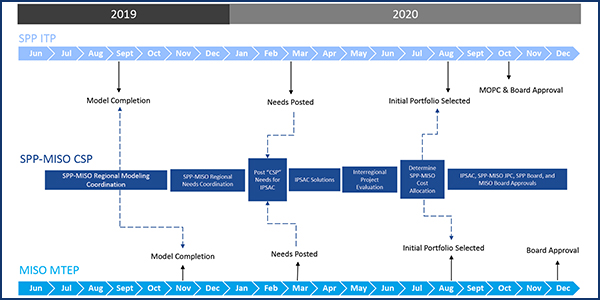By Amanda Durish Cook and Tom Kleckner
MISO and SPP staff are both recommending that the RTOs take another stab this year at a coordinated system plan (CSP) in their elusive pursuit of an interregional project.
Staff have identified 10 congestion areas that merit further evaluation and shared them with stakeholders Tuesday during the Interregional Planning Stakeholder Advisory Committee’s annual issues review. The areas were selected based on their level of congestion and shadow prices, which both RTOs use to identify economic congestion issues.
MISO and SPP have conducted three joint studies since 2014 but have yet to come up with a project to which both could agree. The RTOs modified project criteria last year to improve their chances of reaching an agreement, although differences still remain. The changes included a mandated frequency of CSP studies, elimination of the $5 million cost threshold for the projects, addition of avoided costs and adjusted production cost benefits to project evaluation, and removal of the joint modeling requirement in favor of individual RTO regional analyses. (See MISO, SPP to Ease Interregional Project Criteria.)
The recommendation to undertake a CSP must still be approved by the Joint Planning Committee, which is composed of a representative from each RTO and meets later this month. Assuming its approval, the CSP process would begin shortly thereafter with the scope’s development. Initial portfolios would be filed by each grid operator in August.
The Advanced Power Alliance (APA), American Wind Energy Association and Clean Grid Alliance (CGA) filed a joint letter with the IPSAC supporting the need for interregional planning. They said it is a need that “continues to increase as the use of the grid evolves” with renewable energy’s replacement of fossil fuel generation.
“It should now be clear that forward-looking regional transmission planning is indispensable to ensure both reliability and cost-effective results for customers,” the organizations wrote.
APA’s Steve Gaw highlighted the need to address current restrictions on moving power between MISO North and South. Ben Stearney, MISO’s interregional planning adviser, said the RTO has been evaluating the issue since last year but has found placing the solutions in the CSP to be a “gray area.” (See Interregional Projects May Become Reality for SPP, MISO).
CGA’s Natalie McIntire raised concerns about MISO’s 2019 futures, which are also being used in its 2020 Transmission Expansion Plan models, saying they are “not very representative of what the future is likely to be like.”
Stearney said his staff are working “diligently” on its 2021 futures. However, the futures are not likely to be ready for the 2020 study.
“Part of the advantage of the new process is that it allows us to refresh on an annual basis,” Stearney said.
Regulators’ Seams Committee Wants More Info
Meanwhile, the Organization of MISO States (OMS) and the SPP Regional State Committee’s (RSC) Seams Liaison Committee (SLC) is seeking more information from the RTOs before it scopes its own interregional issues analysis.
The committee decided this week it wants an updated analysis on historical congestion across flowgates and more information on the process behind evaluating interregional reliability projects.
Adam McKinnie, chief economist with the Missouri Public Service Commission, said the SLC is seeking transparency into how individual transmission owners collaborate to propose potential reliability projects across the seams to the RTOs.
“We’re looking for how that evaluation takes place,” McKinnie said during a conference call Monday.
The committee said it has identified “a potential disconnect and general lack of coordination in the [CSP] interregional planning process.”
“Although reliability projects can be proposed through the interregional planning process, this does not occur, and planning for reliability continues to happen predominately separately, or on an ad hoc basis through individual transmission owner collaboration,” the SLC wrote.
To date, MISO and SPP have not approved a seams reliability project, instead favoring regional projects. MISO officials have attributed that to low load growth in recent years, saying the RTOs haven’t had the need for reliability projects along their seams. Staff from the RTOs have also maintained that their reliability planning processes are fundamentally different.
“I don’t have the belief that the seams are so different that we couldn’t benefit from a coordinated reliability process,” McKinnie said.
The SLC will also ask MISO and SPP for a presentation on historical market-to-market congestion using 2018 and 2019 data that could be used in an upcoming CSP. Finally, the SLC is also asking that MISO and SPP detail how it plans to address flowgate congestion now that it has an improved CSP process in place.
The committee won’t select a direction or draft a scope for their seams analysis until they have more information on the two topics.
The OMS and RSC in January laid out the option to either re-examine the RTOs’ past analyses of proposed interregional projects or embark on a series of smaller studies on congested flowgates that could produce entirely new project proposals. (See MISO, PJM Weighing New Interregional Study.)






